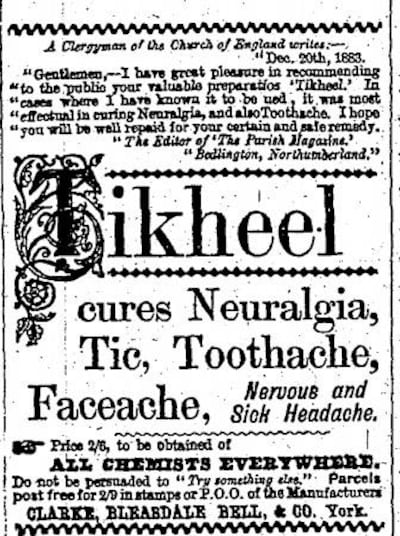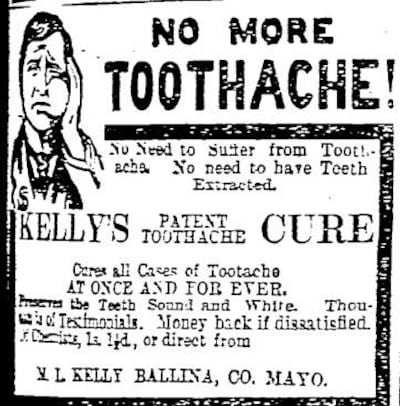“Men are the most careless about their teeth, because they can hide them behind a moustache,” pronounced a brief Irish Times article in 1888, “About the Teeth”.

“Women”, it continued, “are braver about having their teeth fixed than men. They cannot stand as long an operation as a man, but bear up far more pluckily.”
Pluck was certainly one required attribute to attend a 19th century dentist. Even for those who could afford the cost of anaesthesia, there were risks. That same article warned of deaths from “the effects of taking gas”.
Dentists promoted their ability to provide “Painless Dentistry” by a range of distasteful – and potentially dangerous – methods, including chloroform, ether, and later, cocaine.
Stump extraction
Others promised less hazardous “painless tooth and stump extraction by Congelation”, which involved freezing the gum, and later “Protoxide of Nitrogen or Laughing Gas”.
Even the most precarious pain relief, however, would have seemed preferable to the extraction methods employed by the renowned Dr Mounsey of Chelsea Hospital in the previous century, as outlined in an 1899 article: “Round the tooth to be drawn he fastened a strong piece of catgut, to the opposite end of which he fastened a bullet, with which and a strong dose of powder he charged a pistol. On the trigger being pulled, the tooth was drawn out.”

Patients were also unlikely to have been enticed by the “dental vibrator”, an invention documented in 1891. This “masked” the pain of extractions when a patient held on to metal handles connected to an electric coil and experienced “the peculiar sensation of pins and needles” induced by the current!
Dentists also heralded other developments. In 1859, Mr W Eagar, Suffolk Street, noted his application of: "Gutta Percha to the most tender Gums, without the extraction of Stumps or any painful operation".
That natural rubber is still used in root canal treatment today.
By 1876, Mr CW Wall on York Street was practising “American Dentistry – Teeth filled with pure leaf gold . . . the filling lasts a lifetime, and does not discolour the tooth”.
If teeth-filling failed, artificial replacements were available, even in the 1850s, at a cost of five shillings each. A full set, with gold springs, cost £5.
The Dental Hospital of Ireland opened on Dublin's York Street in 1879. The charity's 1882 agm heard that 4,500 operations had been performed the previous year. The purpose of the hospital was: "1st, to afford immediate aid to poor patients suffering from toothache, a class of cases neglected at our general hospitals, or treated in such an unskilful way as practically to defer any unfortunate sufferer from seeking the aid...; 2nd, by carrying out what may be broadly termed conservative dentistry...endeavour to retain for use and health teeth too often removed from the poor by careless operators. Under this head come the various methods of filling teeth, the treatment of irregular teeth, a fruitful cause of disease," and "dental neuralgia, with its thousand terrors."

Toothache was an issue that occupied many column inches. “Of the many every-day ills to which the flesh is heir, toothache is one of the most disagreeable,” began an 1884 article. “In days gone by,”readers were informed, a common superstition in Dublin was “to proceed at an early hour in the morning to some graveyard, and procuring a sharp-pointed piece of wood, with the aching tooth to push it into a newly-made grave.”
An usual suggestion, but perhaps not as off-putting as the electric “cure” created by a Parisian dentist in 1860. A platinum wire was inserted in the tooth and, “by pressing the foot on a pedal, the platina becomes red hot, and destroys the nerve permanently”.
Toothache was so pervasive that inquests recorded fatal overdoses from laudanum and chloroform, taken to find relief. Other toothache remedies may also have been responsible for early deaths, or addictions, as it was unknown what many “elixirs” and patent concoctions contained. Others included alcohol or sedatives such as chloral.
‘Perfectly harmless’
And it was not just adults at risk from “cures” for dental pain. Mothers, “broken in your rest by a sick child suffering with the pain of cutting teeth” were advised to buy: “Mrs. Winslow’s Soothing Syrup. It is perfectly harmless and pleasant to taste. It produces natural, quiet sleep.” However, the syrup was not as “harmless” as described. Its primary ingredients were alcohol and morphine!
Readers, writers and medical contributors, however, regularly shared suggestions for more benign toothache and dental care.
Mary wrote in 1864 that she had found relief by putting “a small blister of brown mustard . . . between tooth and gum”, while readers in 1885 were advised to drink and inhale 5 drops of ammonia in hot water twice a day. A 1900 “Mollie Bawn” column advised a wad of cotton, dipped in equal parts oil of cloves and chloroform.
An earlier “Hints” column in 1893 suggested a mouth wash: “Dissolve a little borax in half a pint of the best eau de cologne, and afterwards add half a pint of myrrh; mix well together. A few drops of this mixture on the tooth-brush will be found most refreshing to the mouth.”

Toothpastes, meanwhile, are no recent invention. Dentifrices – cleansing pastes and powders – were commonly used. Made from nut pastes, carbolic and a variety of ingredients – many abrasive – hyperbole was regularly employed, from the paper’s earliest days, to sell both pastes and potential pain relievers. These included: Langdale’s Raspberry and Cherry Tooth Paste - “the most delicious preparation ever produced for the Teeth, Gums and Breath”, or Floriline, “the greatest toilet discovery of the age . . . It removes all unpleasant odours from decayed teeth, a disordered stomach, or tobacco smoke.”
Ersons Chemists, meanwhile, who in 1859 advertised their Remedy for Toothache and Dentifrice alongside cures for “Ringworm and Scald Heads”, furniture polish, and animal worm powders, became more marketing savvy by 1860, resorting to rhyme:
The Cure of the Toothache!! - the wonderful cure’!!
Instantaneous as lightning!! - and nothing more sure;
No sooner you try it, and put it upon
Your poor aching tooth, then your Toothache is gone!!!
Buy a bottle at once, if you wish for relief;
Its magic effect quite exceeds your belief!!
Don’t wait for the Toothache, but buy it this day
‘Twill act like a charm, and keep Toothache away!!
In bottles, Six Pence or One Shilling’s the cost,
Or Ten Pence and Sixteen Pence sent by the post.
I, Erson, prepare it - the invention is mine -
At Henry-Street, Dublin, number Thirty and Nine.
- This is part of a series looking at the archives of The Irish Times concerning health.
1) Sleeping secrets: undress in the dark
2) Cooking for invalids: wine and champagne
3) Eat fat, no milk: 19 rules of long living
4) Bloody cures for women's periods
5) Electrical cures to revive sluggish functions
6) Your 'flatulence' explain your 'noises'
7) Curing psoriasis with nude sunbathing
8) Weight-loss: Obesity soap and fat massage
9) Institution Dubliners hoped they'd never enter
10) Cocaine Tooth Powder
11) 'Sun-ray' therapy
12) Men's hair products
13) A history of Irish lunacy
14) Prescribing clothes for women
15) Dublin in 1886
16) Poultices
17) Parsing 'painless dentistry'
















